Rome-Tuesday, 1/31/06
We knew Tuesday was going to be a long day (all of it on foot, too), so we got an early start. Thankfully, the weather was absolutely beautiful: temperatures in the 50s; we actually took off our coats during the afternoon.
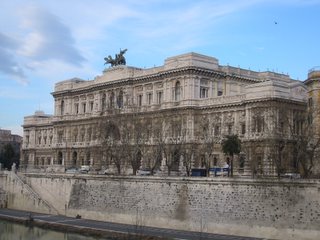 This enormous building is the Palazzo di Guistitia, or Justice Center. It sits on the Piazza Cavour, a block from our hotel and right next to the Castel Sant'Angelo.
This enormous building is the Palazzo di Guistitia, or Justice Center. It sits on the Piazza Cavour, a block from our hotel and right next to the Castel Sant'Angelo.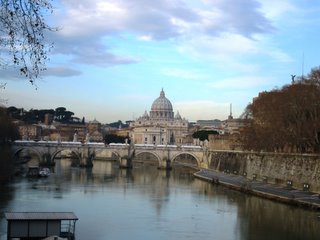 We took this picture of St. Peter's as we were walking along the Tiber in front of the Guistitia.
We took this picture of St. Peter's as we were walking along the Tiber in front of the Guistitia.It was our intention to head first toward the Trevi Fountain, but instead we ended up at Piazza Navona. Everywhere you turn there's something wonderful to take in. Piazza Navona is a rectangular-shaped piazza (which was once a Roman stadium) that includes not only the three fountains pictured below but also the church of Sant'Agnese in Agone (where St. Agnes is said to have been martyred) and two 'palaces,' the Palazzo Pamphili and the Palazzo Madama (where the Medici lived).
 The Fontana di Nettuno is at the north end of the piazza.
The Fontana di Nettuno is at the north end of the piazza.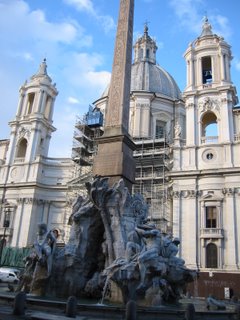 Fontana di Fiume with the obelisk is in the middle of the square.
Fontana di Fiume with the obelisk is in the middle of the square.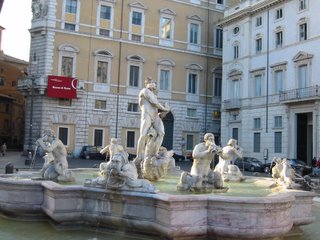 And the Fontana del Moro is at the south end.
And the Fontana del Moro is at the south end. After passing through the Piazza Navona on our way to the Pantheon, we stumbled across this beautiful church, Sant'Andrea della Valle.
After passing through the Piazza Navona on our way to the Pantheon, we stumbled across this beautiful church, Sant'Andrea della Valle. 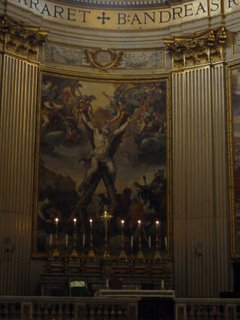 Again, it was incredibly ornate inside, and had this striking 'Times Square' lettering all around the top of the walls of the nave. The start of the inscription is at the top of this photo ("B. Andreas..." is "Blessed Andrew...".) Note the figure of the Apostle crucified on the distinctive X-shaped St. Andrew's cross.
Again, it was incredibly ornate inside, and had this striking 'Times Square' lettering all around the top of the walls of the nave. The start of the inscription is at the top of this photo ("B. Andreas..." is "Blessed Andrew...".) Note the figure of the Apostle crucified on the distinctive X-shaped St. Andrew's cross.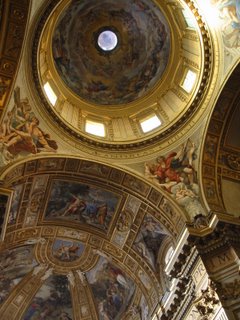 The dome shows Lanfranco's trompe l'oeil painting of the heavenly court.
The dome shows Lanfranco's trompe l'oeil painting of the heavenly court.Next we visited the Pantheon. It is smack dab in the middle of town! You walk along some average-looking streets (average for Rome, that is), turn a corner and, boom, there it is. What was once a temple for Roman gods was turned into the Church of Santa Maria di Martyri in the 7th century.
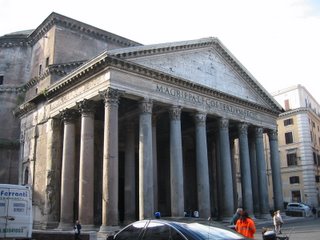
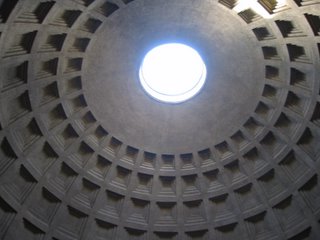 Here is what looking UP at the dome from the inside shows!
Here is what looking UP at the dome from the inside shows!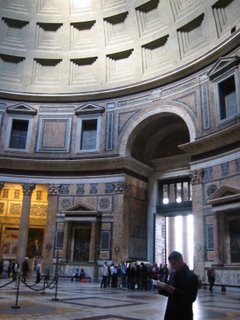 The interior is so grand...
The interior is so grand...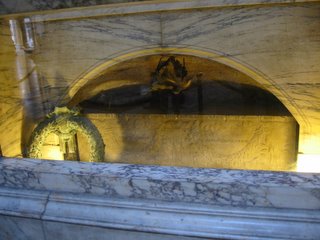 Raphael, the famous artist, is buried here in the Pantheon; nearby is the tomb of Victor Emannuel II, the first king of unified Italy.
Raphael, the famous artist, is buried here in the Pantheon; nearby is the tomb of Victor Emannuel II, the first king of unified Italy.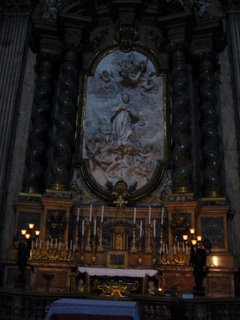 A few blocks away is the church of San Ignazio di Loyola, another extremely ornate Rococo church. Apparently, every major Jesuit saint is interred here! The crypt of St. Aloysius Gonzaga is located in a side chapel.
A few blocks away is the church of San Ignazio di Loyola, another extremely ornate Rococo church. Apparently, every major Jesuit saint is interred here! The crypt of St. Aloysius Gonzaga is located in a side chapel.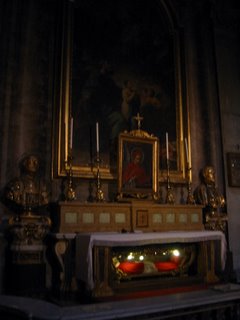 This is the tomb of St. Robert Bellarmine.
This is the tomb of St. Robert Bellarmine. And in this painting to one side of the main altar is depicted the commissioning of Francis Xavier by Ignatius to be a missionary in the Far East.
And in this painting to one side of the main altar is depicted the commissioning of Francis Xavier by Ignatius to be a missionary in the Far East.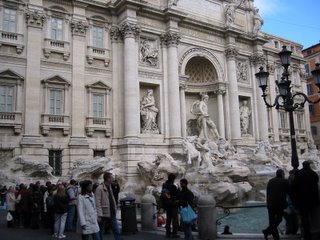 Of course, no visit to Rome is complete without a visit to the Trevi Fountain. It really was built for tourists.
Of course, no visit to Rome is complete without a visit to the Trevi Fountain. It really was built for tourists. Renovations were being made on the exterior of the Chiesa di Gesu, another Jesuit church, so we don't have pictures of it. Here is a view of the stunning fresco on the nave ceiling (by Andrea Pozzo).
Renovations were being made on the exterior of the Chiesa di Gesu, another Jesuit church, so we don't have pictures of it. Here is a view of the stunning fresco on the nave ceiling (by Andrea Pozzo).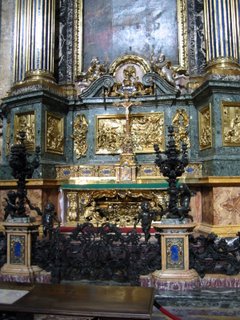 The interior is a Jesuit Hall of Fame: Ignatius, Francis Xavier, Peter Canisius, Aloysius Gonzaga and John Berchmans all have relics and/or chapels dedicated to them. Here is the Capella di Sant'Ignazio, where Ignatius is buried.
The interior is a Jesuit Hall of Fame: Ignatius, Francis Xavier, Peter Canisius, Aloysius Gonzaga and John Berchmans all have relics and/or chapels dedicated to them. Here is the Capella di Sant'Ignazio, where Ignatius is buried.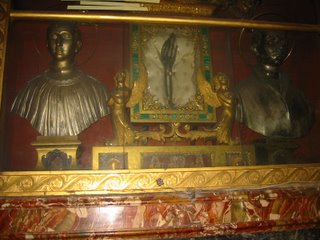 Here in the reliquary is clearly visible the right arm of Peter Canisius!
Here in the reliquary is clearly visible the right arm of Peter Canisius!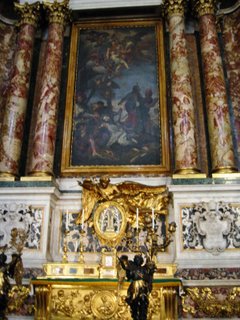 This is the Chapel of St. Francis Xavier.
This is the Chapel of St. Francis Xavier.The Vittoriano (also called the Wedding Cake), one of the more identifiable of Roman buildings, is a memorial to Victor Emmanuel. It sits in the center of the Piazza Venezia.
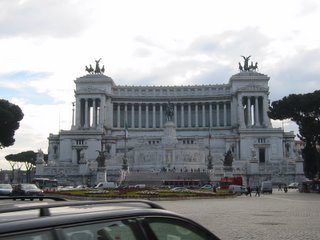
 Behind the Vittoriano, atop the Capitoline hill, is the Piazza Campidoglio (Italian for Capitol). We took this beautiful view of Rome from there.
Behind the Vittoriano, atop the Capitoline hill, is the Piazza Campidoglio (Italian for Capitol). We took this beautiful view of Rome from there.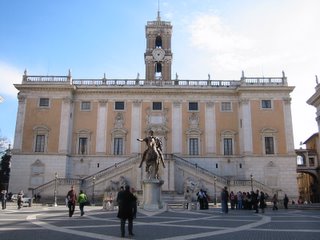 The Piazza del Campidoglio is a delightful square, designed by Michaelangelo. It is said that in 1764, Edward Gibbon was sitting quietly in this square when he conceived the idea of writing Decline and Fall of the Roman Empire. The statue is of Marcus Aurelius, and the building behind is the Palazzo Senatorio, the main administrative buidling for the city.
The Piazza del Campidoglio is a delightful square, designed by Michaelangelo. It is said that in 1764, Edward Gibbon was sitting quietly in this square when he conceived the idea of writing Decline and Fall of the Roman Empire. The statue is of Marcus Aurelius, and the building behind is the Palazzo Senatorio, the main administrative buidling for the city.Crossing the Piazza and descending steps on the other side of the hill, one is struck by a sudden and surprising view of the ancient Roman Forum. It's very hard to explain the experience of viewing the Roman Forum for the first time. To imagine that this place is more than 2500 years old! The three pictures below were taken from atop a viewing balcony. We then walked through the Forum itself (and took too many pictures to upload to this blog).
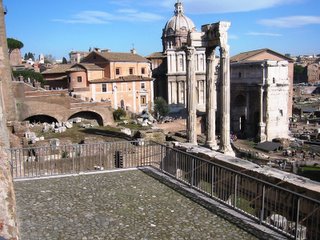
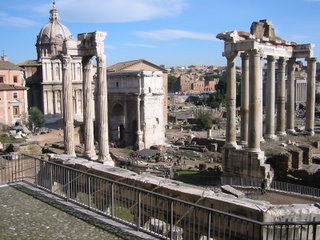
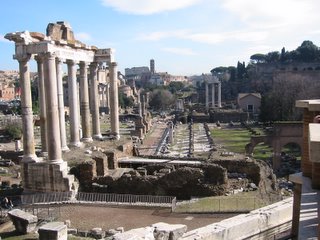
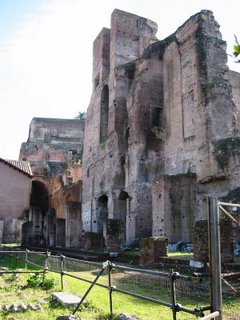 This is the Temple of Augustus.
This is the Temple of Augustus.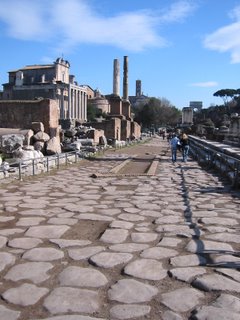 This is a view down the Via Sacra, the main street of ancient Rome and the very center of the city.
This is a view down the Via Sacra, the main street of ancient Rome and the very center of the city.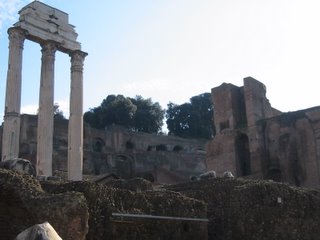
These two pictures show the complex atop the Palatine, a fortress that overlooked the Forum.
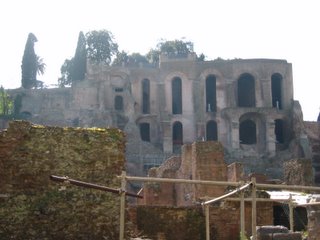
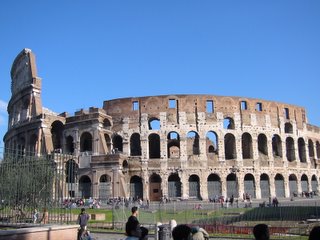

At the opposite end of the Forum is the Colosseum with the Arch of Constantine sitting right by.
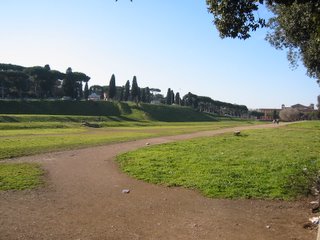
 A short walk down the Via de San Gregorio from the Colosseum leads you to the famous Circus Maximus, now just a long green field. One can still see where the track for the chariot races lay. In the background along the hill would have been the viewing stands for the spectators. We were amused to see a lady running around the track as though it were her local high school athletic field. The second photo shows the ruins of the "clubhouse" where the stables were.
A short walk down the Via de San Gregorio from the Colosseum leads you to the famous Circus Maximus, now just a long green field. One can still see where the track for the chariot races lay. In the background along the hill would have been the viewing stands for the spectators. We were amused to see a lady running around the track as though it were her local high school athletic field. The second photo shows the ruins of the "clubhouse" where the stables were.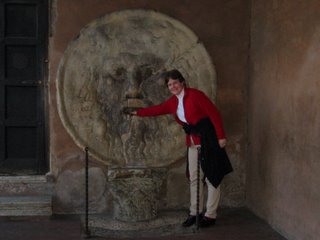 At the far end of the Circus Maximus lies the church of Santa Maria in Cosmedin, where the famous Bocca della Veritá (The Mouth of Truth) is located. Of course, Deb had to stick her hand in the mouth. Thank God she hadn't told a lie!
At the far end of the Circus Maximus lies the church of Santa Maria in Cosmedin, where the famous Bocca della Veritá (The Mouth of Truth) is located. Of course, Deb had to stick her hand in the mouth. Thank God she hadn't told a lie!Our next stop was Santa Sabina, the Mother House of the Dominican Order, on the Aventine hill. Unfortunately, we were a little disappointed by the lack of friendliness toward 'pilgrims' and the lack of information available at the church.
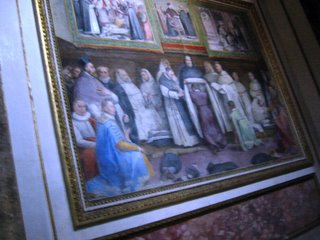 The side chapel is the prettiest part of the church.
The side chapel is the prettiest part of the church. This mosaic of Munio de Zamora, Master General of the Order in the late 12th century, lies on the floor of the nave in front of the choir.
This mosaic of Munio de Zamora, Master General of the Order in the late 12th century, lies on the floor of the nave in front of the choir.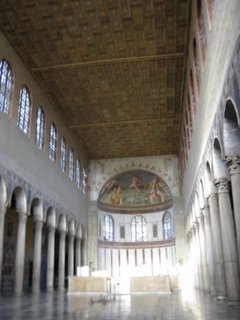 Here is a view of the nave. As you can see, it is very simple and plain, compared to many of the other churches we have seen.
Here is a view of the nave. As you can see, it is very simple and plain, compared to many of the other churches we have seen. A block or two north of the Colosseum is San Pietro in Vincoli (St. Peter in Chains), famous for housing the chains that are said to have bound Peter when he was jailed before his crucifixion by the Romans.
A block or two north of the Colosseum is San Pietro in Vincoli (St. Peter in Chains), famous for housing the chains that are said to have bound Peter when he was jailed before his crucifixion by the Romans. Michelangelo's famous sculpture of Moses is here. There is a sign forbidding people from standing in front of the sculpture "for the purpose of describing it to groups"! We don't understand that one.
Michelangelo's famous sculpture of Moses is here. There is a sign forbidding people from standing in front of the sculpture "for the purpose of describing it to groups"! We don't understand that one.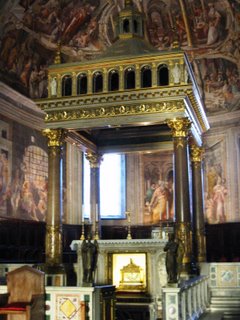 This is the High Altar. You can clearly see the chains hung below the altar.
This is the High Altar. You can clearly see the chains hung below the altar.
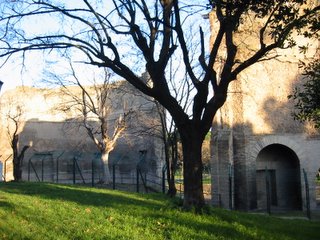
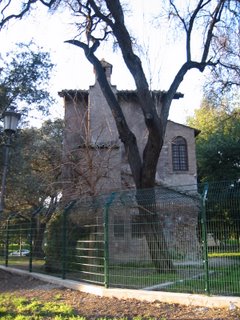 The Domus Aurea, pictured above, was Nero's castle/palace. The only way to get inside is to make a pre-arranged booking. We didn't have one, so these pictures of a couple of building exteriors had to suffice. (Notice the fencing around all the buildings.)
The Domus Aurea, pictured above, was Nero's castle/palace. The only way to get inside is to make a pre-arranged booking. We didn't have one, so these pictures of a couple of building exteriors had to suffice. (Notice the fencing around all the buildings.)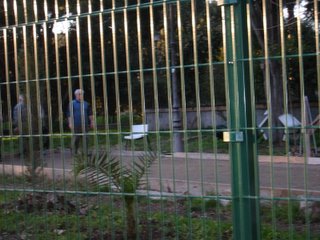 Along the way, we came across an amusing sight: a group of about 10 elderly men playing bocce (apologies for the poor quality of the photo).
Along the way, we came across an amusing sight: a group of about 10 elderly men playing bocce (apologies for the poor quality of the photo). Our last stop on this very long day was at the Basilica of Santa Maria Maggiore, another of the four major basillicas of Rome. This is where Danny saw John Paul II in 1987.
Our last stop on this very long day was at the Basilica of Santa Maria Maggiore, another of the four major basillicas of Rome. This is where Danny saw John Paul II in 1987.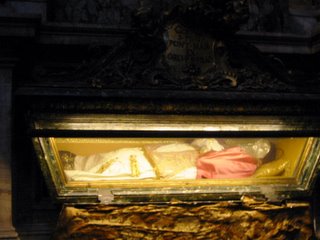 Here is the tomb of St. Pius V (Dominican Pope and saint) in Sta. Maria Maggiore.
Here is the tomb of St. Pius V (Dominican Pope and saint) in Sta. Maria Maggiore.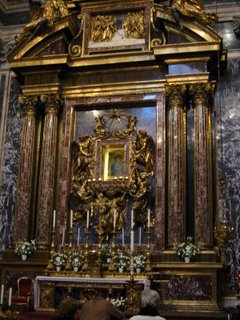 This is a picture of the Borghese Chapel, in the left transept of the basilica.
This is a picture of the Borghese Chapel, in the left transept of the basilica.We were correct in thinking this would be a long and busy day. After about 10-11 hours of walking the city, we actually saw everything we had hoped to see. Thank God for good shoes! Exhausted, we went back to the hotel, after a lovely dinner at a ristorante called La Famiglia. Tomorrow was also going to be a terribly busy day.

2 Comments:
Todas estas fotos están hermosas, los felicito por estar en un lugar tan maravilloso. Gracias por brindarnos la oportunidad de observar estas lindas fotografías.
Dan & Debbie,
I love your blog. Great photos of Rome and the narrative is so fun. It's also great to see Cambridge through your eyes! :)
Post a Comment
<< Home